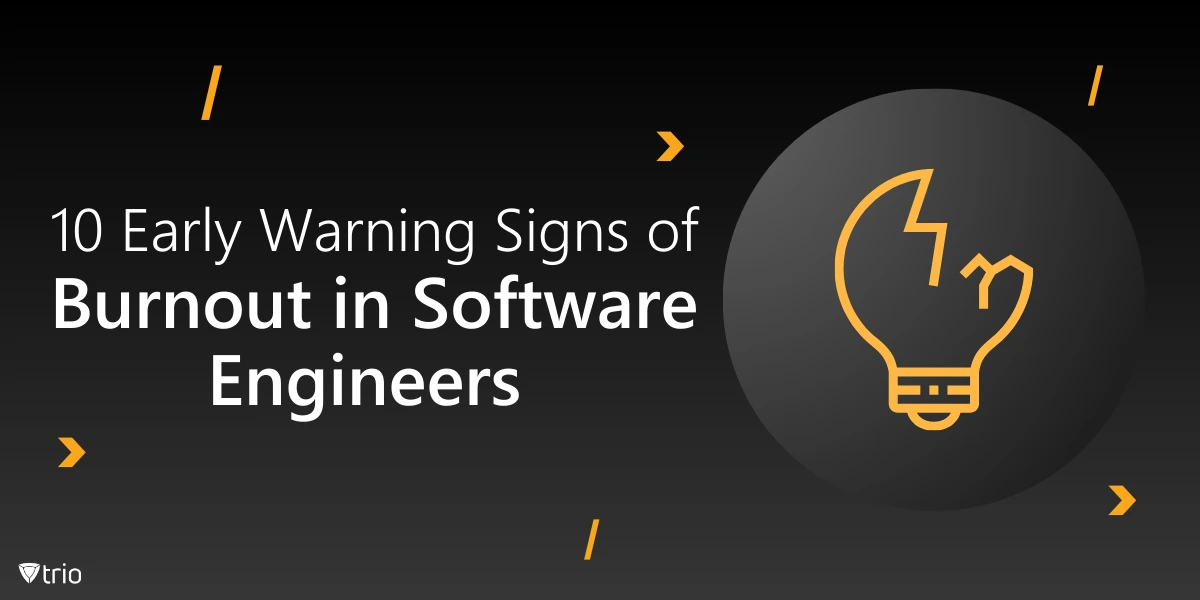Burnout in the tech industry is on the rise. Recent studies suggest that nearly 40% of tech professionals may experience burnout, with 42% of workers considering leaving their jobs in the next six months. Software engineering burnout is particularly prevalent, with the demands of constant coding, problem-solving, and ever-evolving technology pushing engineers to their limits.
Recognizing software engineering burnout early is crucial for IT administrators. When signs of burnout go unnoticed, productivity plummets, and overall team morale suffers. By identifying burnout warning signs and implementing strategies to prevent it, IT admins can look after their teams’ mental health and maintain a positive work environment.
Why Software Engineers Are Prone to Burnout
Let's explore some of the reasons why burnout is so common among software engineers and what drives this issue.
High Workload
One of the key causes of burnout in software engineering is the high workload that engineers face. Coding for long hours, meeting tight deadlines, and constantly delivering projects with high stakes create an environment ripe for stress. The mental strain of juggling complex problems daily can quickly take its toll and lead to exhaustion.
Constant Learning
Another factor contributing to why software engineer's burnout is the relentless need to stay updated. Technology evolves at a rapid pace, and engineers are expected to constantly learn new tools, frameworks, and languages. This pressure to keep up often results in overworking and can erode their passion for the craft.
Isolation & Pressure
The nature of the work often demands solitary focus, but this isolation, combined with high expectations, can lead to burnout. Managing onboarding and offboarding processes, handling complex projects, and feeling the weight of constant problem-solving without support can push engineers beyond their limits.

10 Early Warning Signs of Burnout in Software Engineers
Spotting software engineer burnout symptoms early can make a huge difference in maintaining a positive employee experience and reducing the overall software engineer burnout rate. Here are some key signs to watch for in yourself or your colleagues, to keep that human firewall strong.
1- Decreased Productivity
When engineers begin missing deadlines or taking longer to complete routine tasks, it’s often one of the first visible signs of burnout. The quality of their output may also dip as exhaustion sets in, leading to missed details or sloppy work.
2- Increased Irritability
Burnt-out engineers often show signs of frustration over small issues. Snapping at colleagues or feeling overly annoyed by everyday challenges can signal deeper burnout. This irritability can affect team dynamics and contribute to a negative work environment.
3- Procrastination on Projects
Normally engaged engineers may start delaying tasks or avoiding new assignments altogether. This reluctance to tackle projects can indicate mental fatigue and a lack of motivation, both key software engineer burnout symptoms.
4- Emotional Detachment From Work
Losing passion for the work that once excited them is another common symptom. When engineers become emotionally detached, they may stop caring about their work or disconnect from the team, signaling burnout in its early stages.
5- Physical Fatigue and Health Issues
Burnout doesn’t only show up mentally; physical signs like chronic tiredness, headaches, or sleep issues such as insomnia are often red flags. When engineers start feeling worn out despite adequate rest, the workload might be to blame.
6- Decline in Code Quality
An engineer experiencing burnout might produce buggy or inconsistent code, as their focus and attention to detail begin to wane. Overlooking coding best practices can result in costly mistakes and increased stress for the whole team.
7- Overuse of “Quick Fixes”
Burnt-out engineers may opt for shortcuts or temporary solutions rather than thoroughly addressing problems. This shift towards quick fixes instead of sustainable solutions is often a result of mental exhaustion or the drive to get through tasks faster.
8- Avoidance of Team Communication
If an engineer is suddenly disengaged during meetings or no longer active in Slack channels or emails, it’s worth investigating. Avoiding team interaction is a classic sign of burnout, especially when collaboration becomes a burden.
9- Reduced Creativity and Innovation
Burnout can stifle creativity and innovation. When engineers struggle to generate fresh ideas or troubleshoot in innovative ways, it’s often a symptom of burnout that’s holding them back from their full potential.
10- Expressing Cynicism or Hopelessness
Cynical remarks about projects, the company, or their future role may surface as burnout intensifies. If engineers begin to express hopelessness or disengagement, it’s a serious sign that they’re feeling overwhelmed and exhausted.
How to Avoid Burnout as a Software Engineer
Now that we’ve explored the early signs of burnout, let’s look at some practical ways IT admins can help prevent it from happening in the first place. Here are a few strategies to keep teams engaged, productive, and healthy.
Foster a Supportive Culture
One of the key ways to avoid burnout as a software engineer is by creating a supportive environment. Encourage open discussions about stress, workload, and mental health. When engineers feel comfortable expressing concerns, burnout risks decrease, and the overall workplace atmosphere becomes healthier.
Implement Reasonable Deadlines
A significant factor in how to deal with burnout in software engineers is managing deadlines. IT admins can collaborate with managers to ensure engineers aren’t constantly overwhelmed by unrealistic timelines. By pacing projects realistically, productivity improves and engineers feel less pressured to overextend themselves.
Promote Work-Life Balance
Encouraging a hybrid work model, remote options, and flexible hours are great ways to promote balance. Ensuring clear boundaries for after-hours work helps prevent burnout and allows engineers to recharge, resulting in a more sustainable approach to their workload.
Offer Continuous Learning Support
Supporting continuous education is critical in reducing burnout. Provide access to learning resources and training programs to help engineers stay updated without feeling overwhelmed. Offering these opportunities internally makes it easier for engineers to balance their learning with their day-to-day responsibilities.

How MDM Can Help
Mobile Device Management (MDM) can surprisingly play a crucial role in preventing software engineer burnout by simplifying routine IT tasks. With MDM in place, engineers avoid being burdened by device management issues, allowing them to focus on core responsibilities. Automating device updates, security protocols, and troubleshooting reduces workload and helps combat burnout.
Our MDM solution, Trio, offers real-time device management, advanced security features, and seamless device enrollment. It is the perfect tool to enhance your company’s mobile device strategy. Interested? You can download a free demo today to see how Trio can transform your device management.
Conclusion: Spotting Burnout Early Can Save Your Team
Identifying software engineering burnout early is necessary for keeping teams productive and healthy. By recognizing the warning signs and taking steps like building a supportive culture and implementing realistic deadlines, IT admins can prevent burnout from derailing projects. Keep your eyes open and protect your engineers from burnout today.
Get Ahead of the Curve
Every organization today needs a solution to automate time-consuming tasks and strengthen security.
Without the right tools, manual processes drain resources and leave gaps in protection. Trio MDM is designed to solve this problem, automating key tasks, boosting security, and ensuring compliance with ease.
Don't let inefficiencies hold you back. Learn how Trio MDM can revolutionize your IT operations or request a free trial today!





